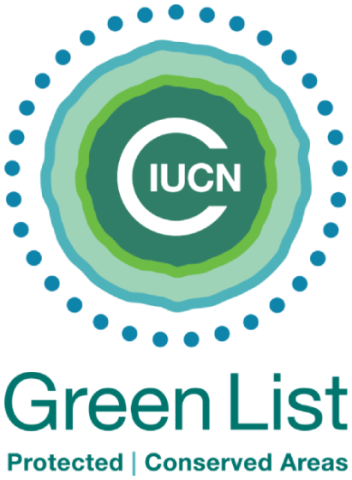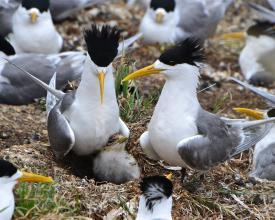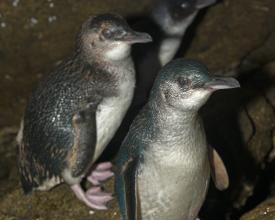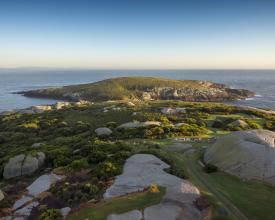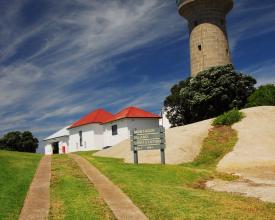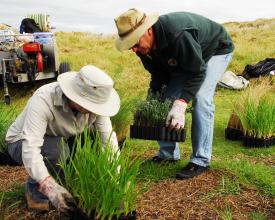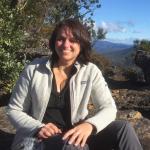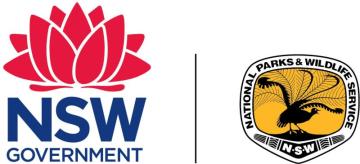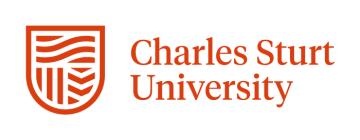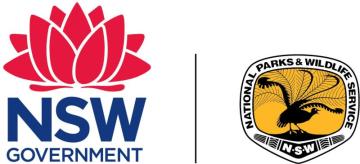
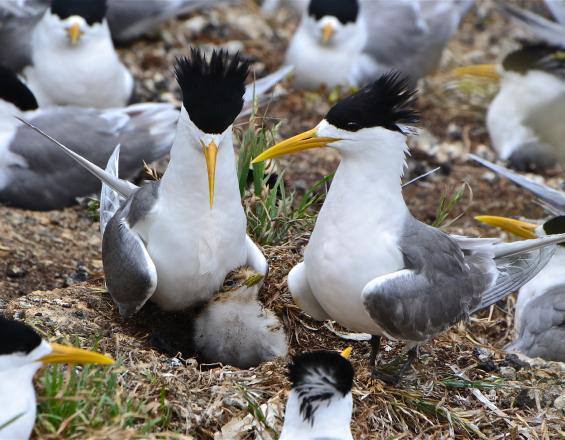
Montague Island Nature Reserve is located off the south coast of New South Wales, Australia. It is managed by the NSW National Parks and Wildlife Service (NPWS) as a haven for wildlife, with thousands of seabirds, including penguins, shearwaters and petrels nesting on the island every year. It is also an important haul out and breeding site for hundreds of Australian and Long Nose Fur seals.
Montague Island is a conservation success because extensive areas of seabird nesting habitat have been restored. The Seabird Habitat Restoration Project eradicated introduced pests, controlled weeds and restored native vegetation.
NPWS collaborated with researchers to identify the best habitat restoration method for the island and mobilised volunteers and local communities. Montague Island now provides a critical vertebrate pest–free environment for nine seabird species. Three of these species have recently been attracted to the island, including the threatened Gould’s Petrel which has established a breeding population.
Context
Challenges addressed
Montague Island was used for ceremony and hunting by local Aboriginal people for thousands of years. In 1881, after the colonisation of Australia, a lighthouse and keepers’ cottages were constructed, and lighthouse keepers and their families brought goats, rabbits, mice and domestic animals that would later become pests. Native vegetation was grazed and damaged and invaded by weeds. Seabirds continued to breed on the island, but the quality of their breeding habitat declined due to the impact of these pests and weeds.
Kikuyu grass was introduced in the 1990’s and spread rapidly throughout seabird nesting habitat. In 2000, kikuyu grass covered over 45% of the island. Large areas of seabird nesting habitat, previously used by nesting little penguins and burrowing shearwaters, became disused and birds became entangled in its thick stems and died. Scientists predicted if no intervention was undertaken, the grass would have potentially spread across south Montague Island within 12 years.
Location
Process
Summary of the process
The ambitious nature and large scale of this project meant that all the building blocks were crucial and interconnected.
The strong foundation of scientific knowledge and involvement on expert scientists provided managers with confidence to proceed. The strong community support and involvement elevated the profile of the project and helped ensure it remained a priority for NPWS and the NSW Environmental Trust in the long term. Significant external funding also ensured that NPWS could complete the project using the relatively expensive, but effective methods developed by scientists and managers.
Building Blocks
Organisational commitment to a bold vision
The success of this project was due to the full support and long-term commitment from all levels of NPWS to a bold vision for an ambitious conservation program. Eradication of mice and rabbits and control of invasive weeds on a relatively large remote island could not be achieved through half measures and was critical to protect this internationally significant site for breeding seabirds. However, a project at this scale had not previously been undertaken in NSW. Organisational commitment ensured the project was prioritised for long term (10 year +) funding and that staff with the right skills and experience were assigned to this project. Partnerships with universities and community organisations were supported and valued. It also meant that NPWS was willing to take risks and try innovative approaches e.g. using fire to control kikuyu grass.
Enabling factors
The long term scientific studies on the island established the significance of the biodiversity values, the impact of the pests and weeds and demonstrated that without this work, all seabird nesting habitat would be overgrown within 12 years. Managers recognised the need to act urgently and at scale to protect these seabird populations. The project was a key feature of the Montague Island Plan of Management (Amendments to the Plan of Management 2003) and the community indicated their strong support for this approach during consultation.
Lesson learned
Support from the whole organisation was required to undertake a project of this scale and complexity. This included support not just from the local area office, but also specialist staff from head office and support of the NPWS executive. This was critical to ensure resources required to sustain and complete the project were prioritised. If populations of mice had only been reduced not eliminated, the populations would have quickly rebounded to original levels wasting all previous efforts and funds. Ongoing work such as weed control is now part of day to day island management and critical to maintain the success.
It is important to recognise the value of and level of commitment and resources required to maintain good communication with stakeholders and community through a public information campaign at all stages of the project.
The ongoing monitoring and evaluation of the project meant that key stakeholders, managers and NPWS executive were receiving regular updates about progress and conservation successes to keep them engaged and ensure their ongoing support.
Strong scientific foundation
The Seabird Habitat Restoration Project was based on a very strong scientific foundation.
The geology, flora and fauna of Montague Island Nature Reserve is relatively well studied as the island has been an important site for environmental monitoring and research for decades. It boasts the world’s longest continuous seabird monitoring program in the world. Therefore, much was known about the species present, their population dynamics, biology and ecology. This baseline information was important in understanding the impact of the kikuyu on seabird breeding success. Scientists had documented the significant impact of the invasive kikuyu grass on increased mortality of Little Penguins and determined the percentage cover of kikuyu that caused significant problems.
Scientific knowledge was critical in the development of the project objective and scope. Scientists from universities and NPWS who were experts in the field of island ecology and seabird biology worked together to identify the most effective method to control kikuyu grass through field trials. They undertook specific research projects and monitored seabird populations and weed distribution. This formed the basis of post graduate Honours and PhD research projects to determine suitable methods of control for use on Montague Island.
Enabling factors
NPWS had a very strong baseline dataset to assess impacts of threats and restoration actions.
NPWS supports scientific research on the island by providing a cottage for use by scientists as a laboratory and base, providing transport to and from the island, and issuing research permits. Scientists, universities and NPWS understand the ecological values of the island and the scale, challenges and opportunities of the project. This made it much easier to develop partnerships and collaborations.
Lesson learned
It was valuable to establish an agreed commitment of all parties in this project through a Memorandum of Understanding to clarify each partners roles and responsibilities.
The scientific research undertaken to provide a basis for the restoration work and to evaluate its success has also been of great value in managing the island since the end of the project. For example, it has enabled the development of thresholds of management performance and triggers for management action.
Montague Island managers review research permit applications and only support projects that relate directly to improved management of the island or improved conservation of species and habitats locally and regionally.
Sufficient long-term funding
Eradicating pests and controlling invasive weeds on a large offshore island requires a commitment of significant resources over a long time to ensure 100% success and support ongoing management and monitoring. Otherwise the pests and weeds would simply regenerate. The length of the project, the number of staff with specialist expertise and types of equipment required e.g. helicopters and boats meant that the project was expensive. Therefore, sustained funding over the life of the project was needed to complete the project in stages. This was critical to the success of the project. After a three-year pilot project started in 2001 to identify the best method for restoration, full implementation began in 2004 with the support of NPWS, Charles Sturt University and external funding from the NSW Environmental Trust of $200,000 over four years.
Enabling factors
Funding was obtained from the NSW Environmental Trust because the project was a high priority for NPWS, had a strong scientific basis for the work and built on existing partnerships with scientific experts. NPWS had a proven track record in effective and efficient use of funds from NSW Environmental Trust. Local managers built a strong relationship with the NSW Environmental Trust representatives leading to long-term funding for the project.
Lesson learned
The Environmental Trust, which funds many NPWS projects, provided significant funding to this project over multiple grant cycles. External funding not only boosted the resources available, but also ensured milestones were set and tracked and NPWS reported on progress regularly. However, as donor priorities can change quickly, it is preferable to secure external funding for the entire duration of the project. This reduces the risk of not having enough funds to complete the project.
Community engagement and volunteering
Community support and involvement in the project was critically important to its success. The restoration project was a key feature of the draft Plan of Management and received strong positive support during community consultation. During the development of the project, managers consulted with local organisations including Aboriginal Elders and communities, the Royal Society for Prevention of Cruelty to Animals and seabird scientists.
Volunteers and the community were instrumental in helping overcome logistical challenges such as replanting thousands of native seedlings. Diverse organisations offered to help including local community members, local school students, Charles Sturt University undergraduate students and ecotour participants.
Interest in the island has expanded and the island is now an iconic tourist destination. Visitors join a NPWS ranger or trained volunteer on an education tour to learn about the island, its wildlife and history. In addition to supporting a thriving tour boat industry, educational tourism creates a greater awareness of the conservation value of the island, its unique wildlife and its value to the local community.
Enabling factors
Community participation was built in at the planning phase so volunteers were fully supported and supervised. Volunteers worked on suitable activities such as planting seedlings, weeding, making nest boxes and marking Little Penguin burrows. Volunteers were able to stay overnight in restored cottages. The conservation volunteer program was a partnership between NPWS and Conservation Volunteers Australia. The program offered fully escorted day and overnight tours of the island with visitors required to work each day.
Lesson learned
A volunteer program requires a sustained commitment from both the volunteers and management to ensure that volunteers are able to undertake meaningful work safely. In an island with sensitive conservation and cultural values it was important to balance the number of volunteers and the type of activities they could undertake. For example, volunteer involvement in the seabird research program was limited to only one volunteer at a time due to stress on chicks caused by ‘crowding’ of multiple people around burrows.
We observed that by valuing our volunteers, the benefits of the program were multiplied. Volunteers became advocates for the program in the community and stayed on as volunteer tour guides on the island after the rehabilitation program was completed.
Impacts
The extent, distribution and condition of seabird nesting habitat on Montague Island has significantly improved since the implementation of the Seabird Habitat Restoration Project. As a result, NPWS has established a vertebrate pest free status on the island, reduced the cover of kikuyu grass in seabird nesting habitat to less than 25% and replanted more than 80,000 native plants. Each year more than 22,000 breeding pairs of nine species of seabirds nest on the island. These include short-tailed, wedge-tailed and sooty shearwaters, Little Penguins, silver gulls and crested terns. Since habitat restoration, three seabird species Gould’s Petrel, White-faced Storm Petrel and Caspian Terns (not previously recorded on the island) have established breeding colonies. Seabird populations on Montague Island also support healthy regional populations with populations established on other islands.
The abundant wildlife and historic lighthouse make Montague Island one of the most well-known destination for visitors. Over 6000 people visit the island each year for guided education day tours and overnight stays supporting a thriving local tour boat industry.
Montague Island is a global example of how to restore an island. It is an important research site and studies here have contributed significantly to our understanding of seabird population dynamics including the impact of climate.
Beneficiaries
The restoration project has benefited:
- NSW NPWS
- Local community
- Seabird populations
- Bush regeneration organisations
- Research community
- Tourism industry
Sustainable Development Goals
Story
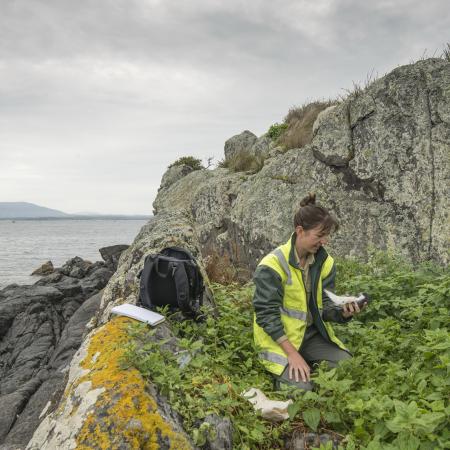
Scientific research and monitoring is a critically important activity on Montague Island as the research informs local management on the island, but also contributes to our understanding of regional and global ecosystems and the impact of climate change. Research on the natural values of Montague Island has contributed significantly to our understanding of wildlife populations on the island and improved management of island ecosystems in other places. The methods used for the Seabird Habitat Rehabilitation Project, approach distances for seals and other marine wildlife, management of visitors and threshold levels for management effort of weed control are all based on the results of scientific research. As a result, Montague Island provides a global example of how to restore an island. The results and lessons from Montague Island are used to develop management strategies in other islands along the NSW and Victorian coastline.
Montague Island is an excellent place to undertake wildlife research with dedicated housing and facilities for researchers and regular transport to the island and easy access to seabird, shorebird and seal colonies making it the ‘perfect laboratory’. Montague Island boasts the world’s longest running continuous seabird surveys that have been undertaken annually since 1960 by a group of world renowned seabird researchers. Originally from universities, these researchers are now retired, but have formed The Montagu Island Partners Research Group and continue to work with NPWS to survey seabird populations annually. This data provides an excellent basis for an analysis of the effectiveness of the Seabird Habitat Restoration Project and ongoing management efforts by NPWS as well as revealing the impact of weather events and climate change impacts on seabird populations in NSW and globally.
Dr Amy Harris developed the methods for the removal of kikuyu grass, while protecting seabirds on Montague Island, as her PhD research. She was supervised by these researchers. She now works for NPWS as the Montague Island ranger, thereby continuing her long-term connection with the island and ensuring continuity of the knowledge of the island and the research that helps inform adaptive management.

